Ordnance may refer to:
Ordnance may refer to:

Artillery is a class of heavy military ranged weapons that launch munitions far beyond the range and power of infantry firearms. Early artillery development focused on the ability to breach defensive walls and fortifications during sieges, and led to heavy, fairly immobile siege engines. As technology improved, lighter, more mobile field artillery cannons developed for battlefield use. This development continues today; modern self-propelled artillery vehicles are highly mobile weapons of great versatility generally providing the largest share of an army's total firepower.

Anti-aircraft warfare, counter-air or air defence forces is the battlespace response to aerial warfare, defined by NATO as "all measures designed to nullify or reduce the effectiveness of hostile air action". It includes surface based, subsurface, and air-based weapon systems, associated sensor systems, command and control arrangements, and passive measures. It may be used to protect naval, ground, and air forces in any location. However, for most countries, the main effort has tended to be homeland defence. NATO refers to airborne air defence as counter-air and naval air defence as anti-aircraft warfare. Missile defence is an extension of air defence, as are initiatives to adapt air defence to the task of intercepting any projectile in flight.
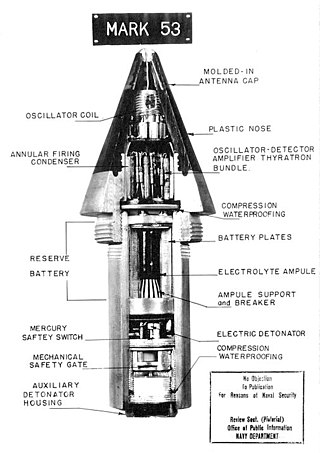
A proximity fuze is a fuze that detonates an explosive device automatically when the distance to the target becomes smaller than a predetermined value. Proximity fuzes are designed for targets such as planes, missiles, ships at sea, and ground forces. They provide a more sophisticated trigger mechanism than the common contact fuze or timed fuze. It is estimated that it increases the lethality by 5 to 10 times, compared to these other fuzes.
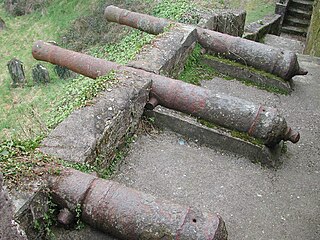
In military organizations, an artillery battery is a unit or multiple systems of artillery, mortar systems, rocket artillery, multiple rocket launchers, surface-to-surface missiles, ballistic missiles, cruise missiles, etc., so grouped to facilitate better battlefield communication and command and control, as well as to provide dispersion for its constituent gunnery crews and their systems. The term is also used in a naval context to describe groups of guns on warships.
OD or Od may refer to:
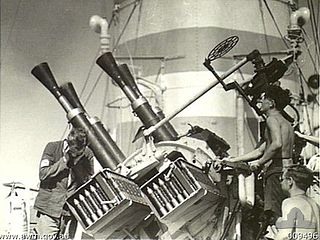
The 2-pounder gun, officially the QF 2-pounder and universally known as the pom-pom, was a 40 mm (1.6 in) British autocannon, used as an anti-aircraft gun by the Royal Navy. The name came from the sound that the original models make when firing. This QF 2-pounder was not the same gun as the Ordnance QF 2-pounder, used by the British Army as an anti-tank gun and a tank gun, although they both fired 2 lb (0.91 kg), 40 mm (1.6 in) projectiles.
In ballistics, the elevation is the angle between the horizontal plane and the axial direction of the barrel of a gun, mortar or heavy artillery. Originally, elevation was a linear measure of how high the gunners had to physically lift the muzzle of a gun up from the gun carriage to compensate for projectile drop and hit targets at a certain distance.

The Type 96 25 mm gun was an automatic cannon used by the Imperial Japanese Navy during World War II. A locally-built variant of the French Hotchkiss 25 mm anti-aircraft gun, it was designed as a dual-purpose weapon for use against armored vehicles and aircraft, but was primarily used as an anti-aircraft gun in fixed mounts with one to three guns.
Zeus is a Greek god, the ruler of Mount Olympus and the king of the gods.

The Flak 30 and improved Flak 38 were 20 mm anti-aircraft guns used by various German forces throughout World War II. It was not only the primary German light anti-aircraft gun but by far the most numerously produced German artillery piece throughout the war. It was produced in a variety of models, notably the Flakvierling 38 which combined four Flak 38 autocannons onto a single carriage.
ODL may refer to:
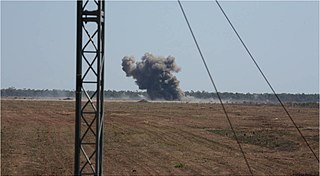
A bombing range usually refers to a remote military aerial bombing and gunnery training range used by combat aircraft to attack ground targets, or a remote area reserved for researching, developing, testing and evaluating new weapons and ammunition. Bombing ranges are used for precision targeting of high-explosive aerial bombs, precision-guided munitions and other aircraft ordnance, as opposed to a field firing range used by infantry and tanks. Various non-explosive inert "practice bombs" are also extensively used for precision aerial targeting bombing practice—to simulate various explosive aerial bomb types and minimise damage and environmental impact to bombing ranges.
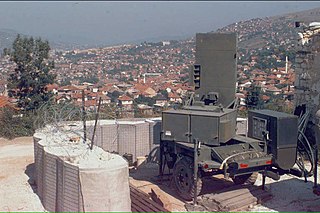
Hughes AN/TPQ-36 Firefinder weapon locating system is a mobile radar system developed in the mid-late 1970s by Hughes Aircraft Company and manufactured by Northrop Grumman and ThalesRaytheonSystems, achieving initial operational capability in May 1982. The system is a "weapon-locating radar", designed to detect and track incoming mortar, artillery and rocket fire to determine the point of origin for counter-battery fire. It is currently in service at battalion and higher levels in the United States Army, United States Marine Corps, Australian Army, Portuguese Army, Turkish Army, and the Armed Forces of Ukraine.

Hughes AN/TPQ-37 Firefinder Weapon Locating System is a mobile radar system developed in the late 1970s by Hughes Aircraft Company, achieving Initial Operational Capability in 1980 and full deployment in 1984. Currently manufactured by ThalesRaytheonSystems, the system is a long-range version of "weapon-locating radar", designed to detect and track incoming artillery and rocket fire to determine the point of origin for counter-battery fire. It is currently in service at brigade and higher levels in the United States Army and by other countries. The radar is trailer-mounted and towed by a 2+1⁄3-short-ton (2,100 kg) truck. A typical AN/TPQ-37 system consists of the Antenna-Transceiver Group, Command Shelter and 60 kW Generator.
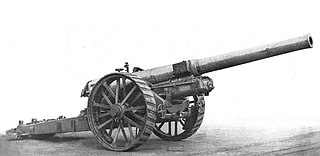
The British BL 6-inch gun Mk XIX was introduced in 1916 as a lighter and longer-range field gun replacement for the obsolescent BL 6-inch gun Mk VII.
6-pounder gun or 6-pdr, usually denotes a 57-millimetre (2.2 in) gun firing a projectile weighing approximately 6 pounds (2.7 kg).
The COW 37 mm gun was a British automatic cannon that was developed during First World War as a large-calibre aircraft weapon. It was tested in several installations and specified for the Westland C.O.W. Gun Fighter for attacking bombers. The tests did not yield satisfactory results and the weapon did not enter general service except on a few flying boats. The design was later adapted as the basis of the Vickers S, which saw some service during the Second World War as an anti-armour weapon.

Ammunition is the material fired, scattered, dropped, or detonated from any weapon or weapon system. Ammunition is both expendable weapons and the component parts of other weapons that create the effect on a target.
In military munitions, a fuze is the part of the device that initiates function. In some applications, such as torpedoes, a fuze may be identified by function as the exploder. The relative complexity of even the earliest fuze designs can be seen in cutaway diagrams.

The 75 mm gun M1916 was a US Army field artillery piece used during and after World War I. It was used as an anti-aircraft gun as well as a field piece. It originated as the 3-inch gun M1913, which was soon modified to the 3-inch gun M1916, which was later altered to the subject weapon.